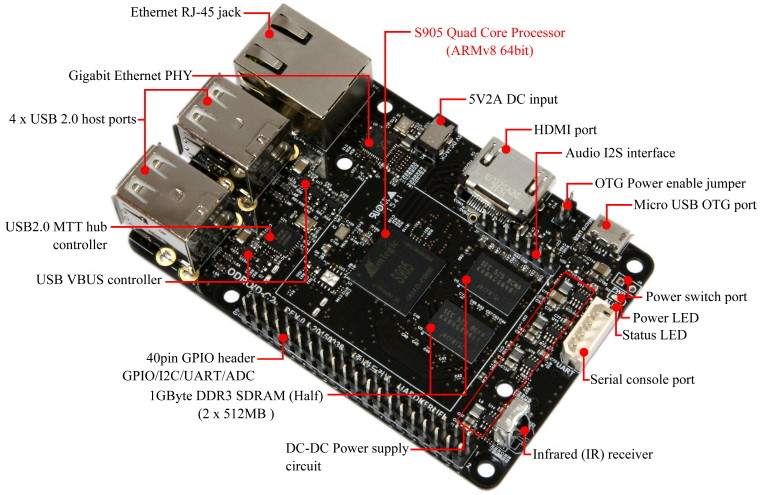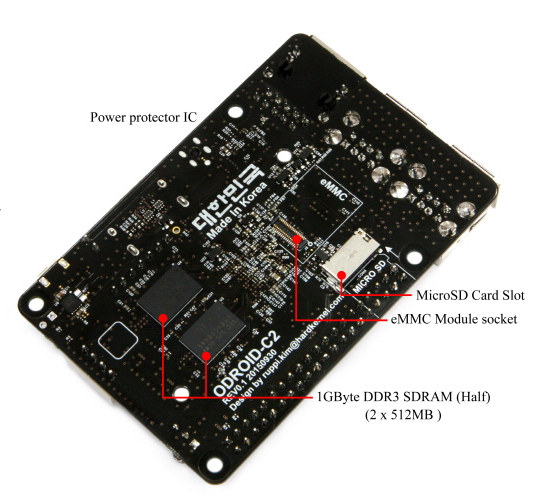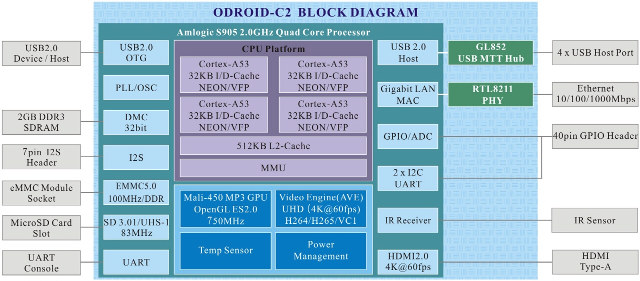We previously knew ODROID-C2 was in development thanks to a document and source code from Amlogic themselves. We did not have the full details at the time, and Amlogic’s document even got the RAM capacity wrong. Hardkernel has finally announced ODROID-C2 development board based on Amlogic S905 will be selling on March 2016 for $40, and released specifications and some photos.

ODROID-C2 specifications:
- SoC – Amlogic S905 quad core cortex-A53 processor with 3+2 cores Mali-450 GPU
- System Memory – 2GB DDR3 SDRAM
- Storage – eMMC module socket with 8, 16, 32, or 64GB module by Toshiba or Sandisk + micro SD slot supporting UHS-1 SD cards.
- Video Output – HDMI 2.0
- Connectivity – Gigabit Ethernet (Realtek RTL8211F)
- USB – 4x USB 2.0 host ports + micro USB OTG port
- Expansion Header
- 40-pin header with GPIO, I2C, UART, and ADC ; All I/Os are 3.3V, except ADC that is limited to 1.8V.
- I2S interface
- Debugging – Serial console port (3.3V)
- Misc – Status & power LEDs, IR receiver, boot selector, power jumper
- Power Supply – 5V/2A DC input via 0.8mm/2.5mm power barrel, or micro USB port (selectable via jumper)
- Power Consumption – Less than 500mA in most cases, and up to 2A with USB peripherals
- Dimensions – 85 x 56mm (Same as ODROID-C1+)
 The board will ship with a heatsink covering most of the board, and the company will provide Ubuntu 16.04 and Android 5.1 Lollipop images and source code based on Linux kernel 3.14 LTS. Beside having the same dimensions as ODROID-C1+, the board layout look identical to me so any enclosure and accessories for the 32-bit board should probably be mechanically and electrically compatible with ODROID-C2, except if you need an SPI interface or the internal RTC both of which are lacking on Amlogic S905.
The board will ship with a heatsink covering most of the board, and the company will provide Ubuntu 16.04 and Android 5.1 Lollipop images and source code based on Linux kernel 3.14 LTS. Beside having the same dimensions as ODROID-C1+, the board layout look identical to me so any enclosure and accessories for the 32-bit board should probably be mechanically and electrically compatible with ODROID-C2, except if you need an SPI interface or the internal RTC both of which are lacking on Amlogic S905.

You can already find some hardware and software documentation on ODROID-C2 wiki, as well as the Android 5.1.1 firmware image.
ODROID-C2 board production will start on February 15, 2016, you’ll be able to purchase the board on March 2, 2016 for US$40 + shipping fees, and actual shipping is scheduled for March 4, 2016.

Jean-Luc started CNX Software in 2010 as a part-time endeavor, before quitting his job as a software engineering manager, and starting to write daily news, and reviews full time later in 2011.
Support CNX Software! Donate via cryptocurrencies, become a Patron on Patreon, or purchase goods on Amazon or Aliexpress




